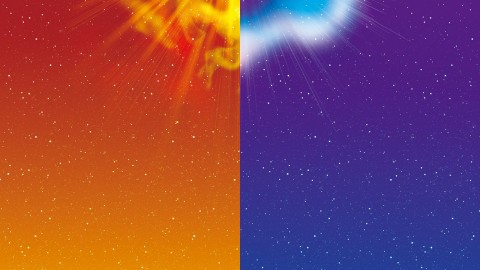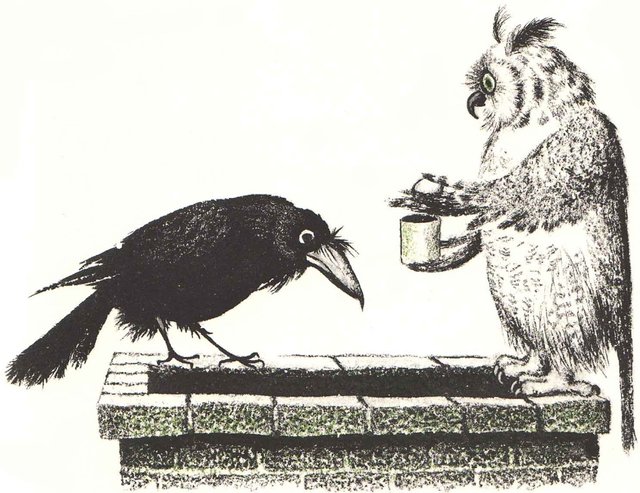HAVING FULFILLED THEIR OBJECT, THE PROCESS OF CHANGE IN THE THREE GUNAS COMES TO AN END.
The whole world of the three gunas: sattva, rajas, tamas, comes to an end. Whenever somebody becomes enlightened, for him the world comes to an end. Of course, others go on dreaming. If there are too many fish suffering on the bank, in the hot sand, in the burning sun, and one fish tries and tries and jumps into the ocean, again back home, for her, or for him, the hot sun and the burning sand and all the misery has disappeared. It is already a nightmare of the past; but for others, it exists.
When a fish like Buddha, Patanjali, jumps into the ocean, for them the world has disappeared. They are again back in the cool womb of the ocean. They are back again, joined, connected to infinite life. They are no longer disconnected; they are no longer alienated. They have become aware. They have come back with a new understanding: alert, enlightened – but for others the world continues.
These sutras of Patanjali are nothing but messages of a fish who has reached home, trying to jump and say something to the people who are still on the bank and suffering. Maybe they are very close to the ocean, just on the border, but they don’t know how to enter; into it. They are not making enough effort, or, are making them in the wrong directions, or, are simply lost in misery and have accepted that this is what life is, or, are so frustrated, discouraged, that they are not making any effort. Yoga is the effort to reach that reality with which we have become disconnected. To be reconnected is to be a yogi. Yoga means: re-connection, re-union, re-merging.
KRAMAHA, THE PROCESS, IS THE SUCCESSION OF CHANGES THAT OCCUR FROM MOMENT TO MOMENT, WHICH BECOME, APPREHENSIBLE AT THE FINAL END OF THE TRANSFORMATIONS OF THE THREE GUNAS.
In this small sutra Patanjali has said everything that modern physics has come to discover. Just thirty or forty years ago, it would have been impossible to understand this sutra because the whole quantum physics is present, in seed form, in this small sutra. And this is good, because this is just the last-but-one. So Patanjali summarizes the whole world of physics in this last-but-one sutra: then, the METAphysics. This is essential physics. The greatest insight that has come to physics in this century is the theory of quantum.
Max Planck discovered a very unbelievable thing. He discovered that life is not a continuity; everything is discontinuous. One moment of time is separate from another moment of time, and between the two moments of time there is a space. They are not connected; they are disconnected.
One atom is separate from another atom, and between the two atoms there is great space. They are not connected. This is what he calls ‘quanta’: distinct, separate atoms not bridged with each other, floating in infinite space, but separate – just as you pour peas from one carton into another and the peas all fall, separate, distinct, or, if you pour oil from one container into another, the oil falls in a continuity.
The existence is like peas, separate. Why does Patanjali mention this? – Because he says, “One atom, another atom: these are two things the world consists of. Just between the two is the space. That is what the whole consists of, the God. Call it space, call it brahma, call it purusa or whatsoever you like; the world consists of distinct atoms, and the whole consists of the infinite space between the two.”
Now physicists say that if we press the whole world and press space out of it, all the stars and all the suns can be pressed into just a small ball. Only that much matter exists. It is really space.
Matter is very rare, here and there. If we press the earth very much, we can put it into a matchbox.
If all the space is thrown out, unbelievable! “And that too, if we go on pressing it still more,” Patanjali says, “then even that small quantity will disappear.” Now physicists say that when matter disappears it leaves black holes.
Everything comes out of nothingness, plays around, disappears again into nothingness. As there are material bodies: earth, sun, stars, there are, just similar to them, empty holes, black holes.
Those black holes are nothingness condensed. It is not simply nothingness; it is very dynamic – whirlpools of nothingness. If a star comes by a black hole, the black hole will suck it in. So it is very dynamic, but it is nothing – no matter in it, simply absence of matter; just pure space, but tremendously powerful. It can suck any star in, and the star will disappear into nothingness; it will be reduced to nothingness. So ultimately, if we try, then all matter will disappear. It comes out of a tremendous nothingness, and it drops again into a tremendous nothingness: out of nothingness, and back into nothingness.
KRAMAHA, THE PROCESS – THE PROCESS OF QUANTUM – IS THE SUCCESSION OF CHANGES THAT OCCUR FROM MOMENT TO MOMENT WHICH BECOMES, APPREHENSIBLE AT THE FINAL END OF THE TRANSFORMATIONS OF THE THREE GUNAS.
This the yogi comes to see at the final stage, when all the three gunas are disappearing into black holes, disappearing into nothingness. That’s why yogis have called the world maya, a magic show.
Have you seen a magician producing a mango tree within seconds, and then it goes on growing; and not only that – within seconds mangoes have appeared… out of nothing? It is just illusory; he creates illusion. Maybe he sends deep messages to your unconscious mind. It is just like deep hypnosis.
He creates the idea, but he visualizes his idea so deeply and he impresses it on your unconscious so deeply that you also start seeing it as he wants you to see it. Nothing is happening. The tree is not there, the mango is not there. And it is possible, just out of great imagination, to create a mango tree, and mangoes come. Not only that, but he can pluck one mango and give it to you and you will say, “Very sweet.”
Hindus call the world maya, a magic show. It is God’s imagination. The whole is dreaming, the whole is projecting.
You go to a movie: on a wide screen you see a great story being enacted, and you see that everything seems to be continuous, but it is not. If the film is moved a little slower, you will see that everything is discontinuous – quanta. One picture goes, another comes, another goes, another comes, but between two pictures there is a gap. In that gap you can see the real screen. When the pictures are moving very fast, they create an illusion of movement. Of course, a movie is not a moving film. It is as static a photograph as any other. The movement is illusory because those static photographs are running after each other so fast, the gap between them is so small, that you cannot see the gap. So everything looks as if it is continuous.
I move my hand: to show this hand moving in a film thousands of pictures will be needed of each state of stasis – from this point to this, from this point to this, from this point to this. The one simple movement of the hand will be divided into thousands of small static movements. Then all those pictures move fast: the hand seems to be moving. It is an illusion. Deep down, between two pictures, it is a white screen, empty.
Patanjali says, “The world is nothing but a cinematograph, a projection.” But this understanding arises only when one achieves the last point of understanding. When he sees all gunas stopped, nothing is moving, suddenly he becomes aware that the whole story was created by illusory movement, by fast movement. This is what is happening to modern physics.
First they said when they had come to the atom, “Now this is the ultimate; it cannot be divided any more.” Then they also divided the atom. Then they came to electrons: “Now it cannot be divided any more.” Now they have divided that too. Now they have come to nothingness; now they don’t know what has come. Division, division, division, and a point has come in modern physics where matter has completely disappeared. Modern physics has reached via matter, and Patanjali and the yogis have reached to the same point via consciousness. Up to this last-but-one sutra, physics has reached. Up to this last-but-one sutra, scientists can have an approach, an understanding, a penetration. The last sutra is not possible for scientists, because that last sutra can be achieved only if you move through consciousness, not through matter; not through objects, but directly through subjectivity.
PURUSHARTHA-SUNYANAM GUNANAM PRATIPRASAVAH KAIVALYAM SVARUPA-PRATISTHA VA CITI-SAKTERITI. KAIVALYA IS THE STATE OF ENLIGHTENMENT THAT FOLLOWS THE REMERGENCE OF THE GUNAS, DUE TO THEIR BECOMING DEVOID OF THE OBJECT OF THE PURUSA. IN THIS STATE, THE PURUSA IS ESTABLISHED IN HIS REAL NATURE, WHICH IS PURE CONSCIOUSNESS. FINISH.
KAIVALYA is the state of enlightenment that follows the remergence of the three gunas… when the world stops, when the process, the kramaha of the world stops, when you become able to see between two moments of time and two atoms of matter, and you can move into space, and you can see that everything has arisen out of space and is moving back into space; when you have become so aware that suddenly the illusory world disappears like a dream, then kaivalya. Then you are left as pure consciousness – with no identity, with no name, no form. Then you are the purest of the pure. Then you are the most fundamental, the most essential, the most existential, and you are established in this purity, aloneness.
Patanjali says, “kaivalya is the state of enlightenment that follows the remergence of the gunas, due to their becoming devoid of the object of the Purusa. In this state the Purusa is established in his real nature.” You have come back home. The journey has been long, torturous, arduous, but you have come back home. The fish has jumped into the ocean which is pure consciousness. Patanjali does not say anything more about it, because more cannot be said. And when Patanjali says, “Finish; the end,” he does not only mean that the YOGA SUTRAS finish here. He says, “All possibilities to express ends here. All possibility to say anything about the ultimate reality ends here. Beyond this is only experience. Expression ends here.” And nobody has been able to go beyond it – nobody.
Not a single exception exists in the whole history of human consciousness. People have tried. Very few have even reached to where Patanjali had reached, but nobody has been able to go beyond Patanjali.
That’s why Osho says he’s the alpha and the omega. He starts from the very beginning; nobody has been able to find a better beginning than him. He begins from the very beginning and he comes to the very end. When he says, “Finish,” he’s simply saying expression is finished, definition is finished, description is finished. If you have really come with him up to now, there is only experience beyond.
Now starts the existential. One can be it, but one cannot say it. One can live in it, but one cannot define it. Words won’t help. All languages are impotent beyond this point. Simply saying this much: that one achieves one’s own true nature – Patanjali stops. That’s the goal: to know one’s nature and to live in it – because unless we reach our own natures we will be in misery. All misery is indicative that we are living somehow unnaturally. All misery is simply symptomatic that somehow our nature is not being fulfilled, that somehow we are not in tune with our reality. The misery is not your enemy; it is just a symptom. It indicates. It is like a thermometer; it simply shows that you are going wrong somewhere. Put it all right, put yourself right; bring yourself in harmony, come back, tune yourself. When every misery disappears one is in tune with one’s nature. That nature Lao Tzu calls tao, Patanjali calls kaivalya, Mahavir calls moksha, Buddha calls nirvana. But whatsoever you want to call it – it has no name and it has no form – it is in you, present, right this moment. You have lost the ocean because you have come out of yourself. You have moved too much in the outer world. Move inwards. Now, let this be your pilgrimage: move inwards.
It happened: A Sufi mystic, Bayazid, was going on a pilgrimage to Mecca. It was difficult. He was poor and somehow he had managed the travelling expenses by begging for years. Now he was very happy. He had almost the necessary money to go to Mecca, and then he travelled. By the time he reached near Mecca, just outside the town he met a fakir, his Master. He was sitting there just under a tree, and he said, “Oh fool, where are you going?” Bayazid looked at him; he had never seen such a luminous being. He came near him and the man said, “Give me whatsoever you have! Where are you going?” He said, “I am going to Mecca for a pilgrimage.” He said, “Finish. There is now no need; you just worship me. You can move around me as many times as you like. You can do your parikrama, your circumlocution, around me. I am Mecca.” And Bayazid was so filled with this person’s magnetism that he gave all his money, he worshipped. Then the old man said, “Now go back home”; and he went back home.
When he went into his town people gathered and said, “Something seems to have happened to you. So really it works, going to Mecca works? You are looking luminous, so full of light.” He said, “Stop this nonsense! One old man met me – he changed my whole pilgrimage. He says, ‘Go home,’ and since then I have been going home, inwards. I have arrived. I have arrived, I have reached my Mecca.”
The outer Mecca is not the real Mecca. The real Mecca is inside you. You are the temple of God.
You are the abode of the ultimate. So the question is not where to find the truth, the question is: how have you lost it? The question is not where to go; you are already there – stop going.
Drop from all the paths. All paths are of desire, extensions of desire, projections of desire: going somewhere, going somewhere, always somewhere else, never here.
Seeker, leave all paths, because all paths lead there, and He is here.
PURUSHARTHA-SUNYANAM GUNANAM PRATIPRASAVAH KAIVALYAM SVARUPA-PRATISTHA VA CITI-SAKTERITI.
Tags: Patanjali Yoga Sutra 50 Abode Of The Ultimate










